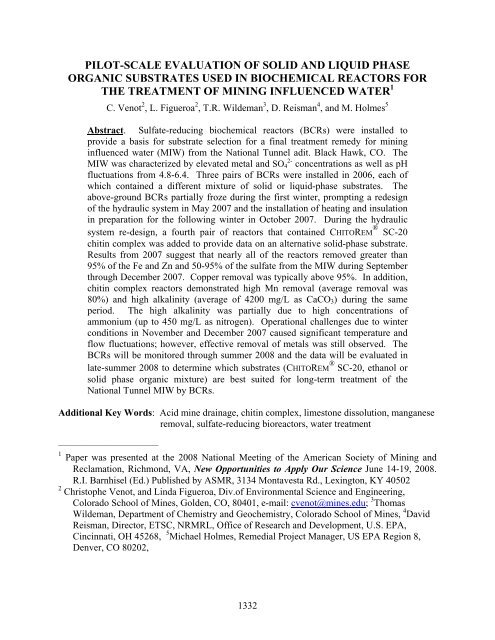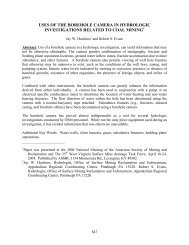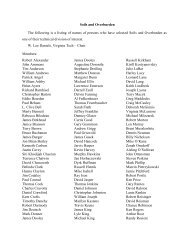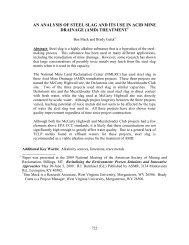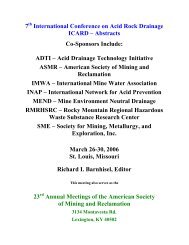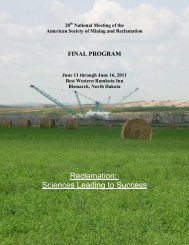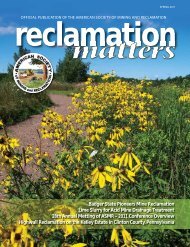1332 - ASMR
1332 - ASMR
1332 - ASMR
You also want an ePaper? Increase the reach of your titles
YUMPU automatically turns print PDFs into web optimized ePapers that Google loves.
Scientific Name: Lynx rufus<br />
Species Code: M-LYRU<br />
Status: Yellow-listed<br />
BOBCAT<br />
Distribution<br />
• Provincial Range<br />
Bobcats are distributed in the southern and central portion of the mainland. They are absent from the<br />
Coast Range north of Bute Inlet.<br />
• Elevational Range: Sea-Level to Timberline<br />
• Provincial Context<br />
Their provincial population is estimated at 5000 to 10000 (Stevens and Lofts 1988).<br />
• Project Area:<br />
Ecoprovince: Southern Interior Mountains<br />
Ecoregions: Columbia Mountains and Highlands, Southern Rocky Mountain Trench<br />
Ecosections: Eastern Purcell Mountains, East Kootenay Trench<br />
Biogeoclimatic Zones: IDFdm2; ICHmk1; ICHmw1; MSdk<br />
Ecology and Key Habitat Requirements<br />
Bobcats are adaptable and therefore are found in a variety of different habitats. They inhabit forested<br />
habitats, wetland habitats and agricultural habitats. Rock piles and broken rocky ledges are used for<br />
breeding, raising young, and shelter from climatic extremes. They also use dense stands of brush, low<br />
hanging conifer boughs, hollow trees and logs as rest areas and thermal cover. Deep snow can<br />
sometimes impede their movements (Banfield 1981).<br />
Bobcats are primarily small game predators. Snowshoe Hares are an important item in their diet.<br />
Other items in their diet include Cottontails, small mammals, birds, reptiles, poultry, Porcupines, deer<br />
and vegetation (Stevens and Lofts 1988).<br />
Breeding occurs in early spring. One to seven kittens are born from late March to July after a gestation<br />
of between 50 and 60 days (Banfield 1981). Birth and early maternal care occurs in dens. Denning<br />
sites include caves, crevices, under logs, or secluded rocky, brushy areas. The kittens remain with their<br />
mother until the following January.<br />
Habitat Use and Life Requisites<br />
The life requisites that will be rated for Bobcats are: feeding, security/thermal cover and reproducing<br />
(birthing) which are described in detail below.<br />
• Feeding Habitat<br />
Bobcats feed primarily on small mammals but they will occasionally kill a deer. They hunt in rocky or<br />
broken terrain with good cover for stalking. It has also been found that they will use recently logged<br />
areas as these habitats provide food and cover for prey species (Stevens and Lofts 1988). They also<br />
forage in forested habitats including Douglas-fir forests and Englemann spruce - subalpine forests.<br />
Bobcats have also been known to use recently logged areas, as these sites provided food and cover for<br />
prey species (Stevens and Lofts 1988).<br />
• Security/Thermal Habitat<br />
Bobcats use rock piles and broken rocky ledges for security and shelter from climatic extremes. They<br />
will also use dense stands of brush, low-hanging conifer boughs, hollow trees and logs as rest areas and<br />
thermal cover (Stevens and Lofts 1988).
• Reproducing (birthing)<br />
Bobcats give birth to kittens in dens in caves, crevices, under logs, or secluded rocky, brushy areas.<br />
They may also utilize talus slopes and rock outcrops with caves for denning and reproducing purposes.<br />
Seasons of Use<br />
Table 1 summarizes the life requisites required for each month of the year.<br />
Table 1. Monthly Life Requisites for Bobcat.<br />
Life Requisite Month Season<br />
Feeding, Security/Thermal January Winter<br />
Feeding, Security/Thermal February Winter<br />
Feeding, Security/Thermal,<br />
Reproducing (birthing)<br />
March Winter<br />
Feeding, Security/Thermal,<br />
Reproducing (birthing)<br />
April Winter<br />
Feeding, Security/Thermal,<br />
Reproducing (birthing)<br />
May Spring<br />
Feeding, Security/Thermal,<br />
Reproducing (birthing)<br />
June Spring<br />
Feeding, Security/Thermal, July Summer<br />
Reproducing (birthing)<br />
Feeding, Security/Thermal August Summer<br />
Feeding, Security/Thermal September Fall<br />
Feeding, Security/Thermal October Fall<br />
Feeding, Security/Thermal November Winter<br />
Feeding, Security/Thermal December Winter<br />
Habitat Use and Ecosystem Attributes<br />
Table 2 outlines how each life requisite relates to specific ecosystem attributes (e.g., site<br />
series/ecosystem unit, plant species, canopy closure, age structure, slope, aspect, terrain<br />
characteristics).<br />
Table 2. Terrestrial Ecosystem Mapping (TEM) Relationships for each Life Requisite for Bobcat.<br />
Life Requisite TEM Attribute<br />
Feeding Habitat - site: site disturbance, elevation, aspect, structural stage<br />
- soil/terrain: bedrock, rock outcrops<br />
- vegetation: % cover by layer<br />
- mensuration: coarse woody debris<br />
Security/Thermal Habitat - site: elevation, aspect, structural stage<br />
- soil/terrain: bedrock, rock outcrops<br />
- vegetation: % cover by layer<br />
Reproducing Habitat<br />
(birthing)<br />
- mensuration: coarse woody debris<br />
- site: elevation, aspect, structural stage<br />
- soil/terrain: bedrock, rock outcrops<br />
- mensuration: coarse woody debris<br />
Ratings<br />
There is and intermediate level of knowledge of the habitat requirements of Bobcats in British<br />
Columbia<br />
and thus, a 4-class rating scheme will be used.<br />
• Provincial Benchmark<br />
Ecosection:<br />
Biogeoclimatic Zone:
Habitats<br />
• Ratings Assumptions<br />
1. Open forested habitats with coarse woody debris will be rated ≤ 3 for feeding and security/thermal<br />
cover.<br />
2. Rock outcrops will be rated ≤ 2 for security/thermal cover and reproducing.<br />
Table 3. Summary of habitat requirements for Bobcat in the study area.<br />
Season Life Requisite Structural Stage Requirements<br />
All Feeding (FD) 2-7 Rocky, broken terrain with good cover<br />
All Security/Thermal(ST) 3-7 rocky ledges, dense stands of brush and coarse woody<br />
debris<br />
Spring Reproducing (RB) 3-7 Rocky, brushy areas with caves, crevices or coarse<br />
woody debris<br />
• Ratings Adjustment Considerations<br />
Final capability and suitability map products may incorporate 1) landscape heterogeneity and<br />
connectivity; 2) habitats adjacent to significant anthropogenic disturbance regimes (e.g. settlements);<br />
3) interspersion of different structural stages within the landscape.<br />
Literature Cited<br />
Banfield, A.W.F. 1981. The Mammals of Canada. University of Toronto Press. Canada.<br />
Stevens, V. 1993. Wildlife Diversity in British Columbia: Distribution and Habitat Use in<br />
Biogeoclimatic Zones Draft Report. Wildlife Interpretations Subgroup. B.C. Ministry of<br />
Environment, Lands, and Parks. B.C. Ministry of Forests. Victoria B.C.<br />
Stevens, V. and S. Lofts. 1988. Wildlife Habitat Handbooks for the Southern Interior Ecoprovince.<br />
Volume 1: Species Notes for Mammals. Wildlife Report No. R-15. Ministry of Environment,<br />
Wildlife Branch. Victoria, B.C.


